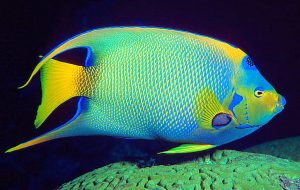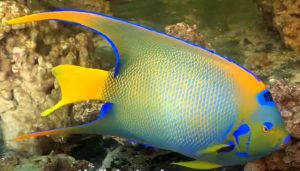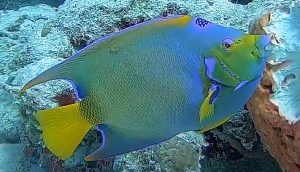The Queen Angelfish (Holacanthus ciliaris) known to tropical fish keeping enthusiasts as the Blue Angelfish, Golden Angelfish, or Yellow Angelfish is found in tropical western Atlantic waters from Florida along the Gulf of Mexico and the Caribbean Sea down to Brazil, as far east as Bermuda, and the St. Peter and St. Paul Archipelago.
Queen Angelfish are a benthic species that can be found on coral reefs at depths from 5 to over 240 feet in areas with live rock, soft corals, and heavy sponge growth. Adults are generally found alone or swimming in pairs grazing on sponges, jellyfish, tunicates, corals, plankton, and algae. Juveniles found in channels, bays, and along the outer reef edges often act as cleaner fish and eat ectoparasites that they remove from larger species.
Queen Angelfish are protogynous hermaphrodites that have large territories and live in harems of two to four or more females to one male. When no male is present, the most dominant female will transform into a male and tend to the harem as the group forages in different locations.
Similar to the Blue Angelfish (Holacanthus bermudensis) the Queen Angelfish (Holacanthus ciliaris) is covered in yellow tipped blue green scales, with a bright yellow tail, pectoral, and pelvic fins. The trailing dorsal and anal fins have orange to yellow end points, and the pectoral fins have blue patches at the base. Adults have a cobalt blue eye like spot (crown) on the forehead with an electric blue outer ring dotted with electric blue spots. The cobalt blue “crown”, solid bright yellow tail, and deep blue highlights distinguish the species from the Blue Angelfish (Holacanthus bermudensis). Although there are no distinguishing markings between adult males and females; males are believed to be larger.
Juvenile Queen Angelfish have brilliant, curved vertical baby blue stripes on their dark blue bodies and bright yellow to orange markings around the mouth, pectoral fins, and tail. They resemble juvenile Blue Angelfish (Holacanthus bermudensis) which have straighter vertical stripes.
Where their ranges overlap, Queen Angelfish will occasionally breed with Blue Angelfish creating a hybrid called the Townsend Angelfish. Seven other color morphs have also been recorded off the coasts of the Saint Peter and Saint Paul Archipelago, Brazil and off the Dry Tortugas. The most common is a mostly gold or bright orange morph. Other morphs are bright blue with some yellow, black or white, and all white.
Because of it’s size, the Queen Angelfish (Holacanthus ciliaris) is best housed in at least a 250 gallon fish only tank with plenty of swimming areas and aged live rock to graze on; arranged into caves, overhangs, and crevices for them to hide among.
They can be kept with other semi aggressive species but because of their aggressiveness towards peaceful species and fish of similar and smaller size, they should never be kept with others of their own kind unless housed in an extremely large aquarium.
Although crabs and shrimp are normally ignored, Queen Angelfish are notorious nippers of stony and soft corals (sessile invertebrates) and clam mantles, and are not considered to be reef safe.
Be sure to have adequate lighting to encourage algae growth on the rock work in your tank before introducing your fish. A daylight bulb is recommended to help the angelfish absorb vitamins A and C.
Queen Angelfish are super sensitive to changes in water parameters and require excellent quality water to thrive. Regular water changes of 10-15% every two weeks for tanks in the 180 gallon range and 30% every 3 to 4 weeks in tanks over 250 gallons are highly recommended to keep them stress free and healthy.
Queen Angelfish are broadcast spawners and to date there have been no successful breedings in an aquarium environment.
Holacanthus ciliaris spawn throughout the year around the full moon by slowly rising up in the water column, with their bellies close together, and releasing large amounts of eggs and sperm. After spawning the pair split up and return to the ocean floor. Females can release anywhere from 25,000 to 75,000 transparent eggs each evening, and as many as ten million during each spawning session. Each pelagic egg contains a single drop of oil to provide buoyancy.
The pelagic eggs normally hatch in 15 to 20 hours into a pro-larval stage where after about 48 hours the large yolk sac is absorbed and the young become free swimming. The free swimming larvae grow quickly and are immediately able to feed on plankton. In about 2 to 4 weeks at a length of .6 to .8 inch the larvae settle to the bottom until they become juveniles. The highly territorial juveniles subsist on parasites that they remove (like cleaner wrasses) from other larger fish at cleaning stations that they set up.
In the wild, adult Queen Angelfish eat mainly sponges, algae, and bryozoans. In an aquarium environment with plenty of mature live rock for grazing, they do well on a diet that includes sponge material in either frozen, freeze dried, flake, or pellet form, vegetables like raw broccoli, marine algae, Spiurlina, and other meaty treats like fresh shrimp, brine, or Mysis shrimp
.
Because they are selective grazers, it is recommended to feed several small meals throughout the day as opposed to one large meal.
Queen Angelfish (Holacanthus ciliaris) are available online from a variety of tropical fish keeping suppliers at the following approximate purches sizes; Tiny: Up to 2″, Small: Over 2-2.5″, Small / Medium: Over 2.5-3.5″, Medium: Over 3.5-4.5″, Medium / Large: Over 4.5-5.5″, Large: Over 5.5-6.5″, Extra Large: Over 6.5-7.5″, Extra Extra Large: Over 7.5-8.5″, Show Size: Over 8.5-10.5″, Jumbo: Over 10.5″. Prices range from under $250.00 to over $500.00.
Minimum Tank Size: 250 gallons
Aquarium Type: Mature live rock
Care Level: Moderate
Temperament: Semi Aggressive
Aquarium Hardiness: Hardy
Water Conditions: 72 °F – 78 °F, dKH 8 to 12, pH 8.1 – 8.4, sg 1.023-1.025
Max. Size: 18″
Color Form: Gold, Blue, Yellow
Diet: Omnivore
Compatibility: Not reef safe
Origin: North and South America, Caribbean
Family: Pomacanthidae
Lifespan: 15 years
Aquarist Experience Level: Expert





One Response to “Queen Angelfish (Holacanthus ciliaris)”
Trackbacks/Pingbacks
[…] Queen Angelfish (Holacanthus ciliaris) posses a solid yellow tail, a striking blue crown, and deep blue highlights. […]